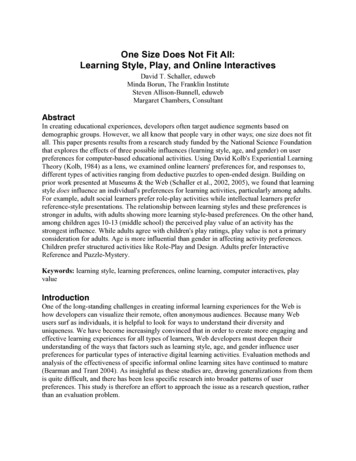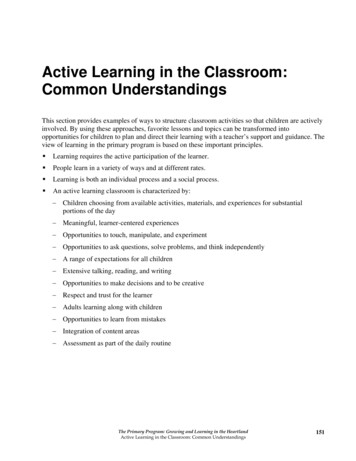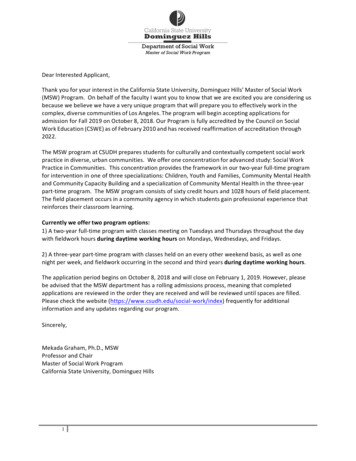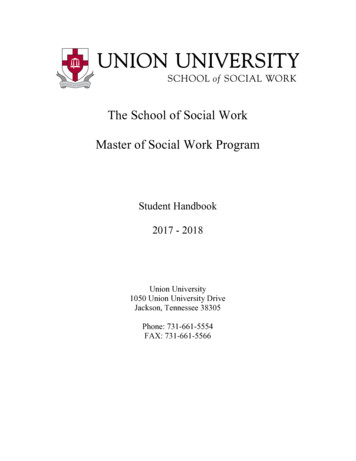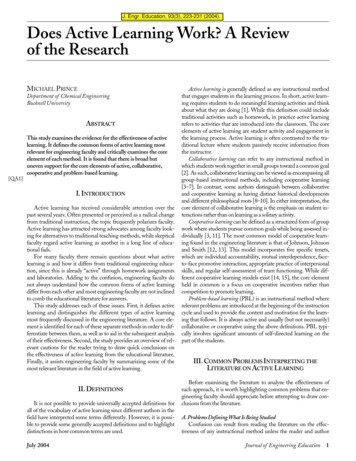
Transcription
J. Engr. Education, 93(3), 223-231 (2004).Does Active Learning Work? A Reviewof the ResearchMICHAEL PRINCEDepartment of Chemical EngineeringBucknell UniversityABSTRACTThis study examines the evidence for the effectiveness of activelearning. It defines the common forms of active learning mostrelevant for engineering faculty and critically examines the coreelement of each method. It is found that there is broad butuneven support for the core elements of active, collaborative,cooperative and problem-based learning.[QA1]I. INTRODUCTIONActive learning has received considerable attention over thepast several years. Often presented or perceived as a radical changefrom traditional instruction, the topic frequently polarizes faculty.Active learning has attracted strong advocates among faculty looking for alternatives to traditional teaching methods, while skepticalfaculty regard active learning as another in a long line of educational fads.For many faculty there remain questions about what activelearning is and how it differs from traditional engineering education, since this is already “active” through homework assignmentsand laboratories. Adding to the confusion, engineering faculty donot always understand how the common forms of active learningdiffer from each other and most engineering faculty are not inclinedto comb the educational literature for answers.This study addresses each of these issues. First, it defines activelearning and distinguishes the different types of active learningmost frequently discussed in the engineering literature. A core element is identified for each of these separate methods in order to differentiate between them, as well as to aid in the subsequent analysisof their effectiveness. Second, the study provides an overview of relevant cautions for the reader trying to draw quick conclusions onthe effectiveness of active learning from the educational literature.Finally, it assists engineering faculty by summarizing some of themost relevant literature in the field of active learning.II. DEFINITIONSIt is not possible to provide universally accepted definitions forall of the vocabulary of active learning since different authors in thefield have interpreted some terms differently. However, it is possible to provide some generally accepted definitions and to highlightdistinctions in how common terms are used.July 2004Active learning is generally defined as any instructional methodthat engages students in the learning process. In short, active learning requires students to do meaningful learning activities and thinkabout what they are doing [1]. While this definition could includetraditional activities such as homework, in practice active learningrefers to activities that are introduced into the classroom. The coreelements of active learning are student activity and engagement inthe learning process. Active learning is often contrasted to the traditional lecture where students passively receive information fromthe instructor.Collaborative learning can refer to any instructional method inwhich students work together in small groups toward a common goal[2]. As such, collaborative learning can be viewed as encompassing allgroup-based instructional methods, including cooperative learning[3–7]. In contrast, some authors distinguish between collaborativeand cooperative learning as having distinct historical developmentsand different philosophical roots [8–10]. In either interpretation, thecore element of collaborative learning is the emphasis on student interactions rather than on learning as a solitary activity.Cooperative learning can be defined as a structured form of groupwork where students pursue common goals while being assessed individually [3, 11]. The most common model of cooperative learning found in the engineering literature is that of Johnson, Johnsonand Smith [12, 13]. This model incorporates five specific tenets,which are individual accountability, mutual interdependence, faceto-face promotive interaction, appropriate practice of interpersonalskills, and regular self-assessment of team functioning. While different cooperative learning models exist [14, 15], the core elementheld in common is a focus on cooperative incentives rather thancompetition to promote learning.Problem-based learning (PBL) is an instructional method whererelevant problems are introduced at the beginning of the instructioncycle and used to provide the context and motivation for the learning that follows. It is always active and usually (but not necessarily)collaborative or cooperative using the above definitions. PBL typically involves significant amounts of self-directed learning on thepart of the students.III. COMMON PROBLEMS INTERPRETING THELITERATURE ON ACTIVE LEARNINGBefore examining the literature to analyze the effectiveness ofeach approach, it is worth highlighting common problems that engineering faculty should appreciate before attempting to draw conclusions from the literature.A. Problems Defining What Is Being StudiedConfusion can result from reading the literature on the effectiveness of any instructional method unless the reader and authorJournal of Engineering Education 1
take care to specify precisely what is being examined. For example,there are many different approaches that go under the name ofproblem-based learning [16]. These distinct approaches to PBLcan have as many differences as they have elements in common,making interpretation of the literature difficult. In PBL, for example, students typically work in small teams to solve problems in aself-directed fashion. Looking at a number of meta-analyses [17],Norman and Schmidt [18] point out that having students work insmall teams has a positive effect on academic achievement whileself-directed learning has a slight negative effect on academicachievement. If PBL includes both of these elements and one asks ifPBL works for promoting academic achievement, the answer seemsto be that parts of it do and parts of it do not. Since different applications of PBL will emphasize different components, the literatureresults on the overall effectiveness of PBL are bound to be confusing unless one takes care to specify what is being examined. This iseven truer of the more broadly defined approaches of active or collaborative learning, which encompass very distinct practices.Note that this point sheds a different light on some of the available meta-analyses that are naturally attractive to a reader hopingfor a quick overview of the field. In looking for a general sense ofwhether an approach like problem-based learning works, nothingseems as attractive as a meta-analysis that brings together the resultsof several studies and quantitatively examines the impact of the approach. While this has value, there are pitfalls. Aggregating the results of several studies on the effectiveness of PBL can be misleading if the forms of PBL vary significantly in each of the individualstudies included in the meta-analysis.To minimize this problem, the analysis presented in Section IVof this paper focuses on the specific core elements of a given instructional method. For example, as discussed in Section II, the core element of collaborative learning is working in groups rather thanworking individually. Similarly, the core element of cooperativelearning is cooperation rather than competition. These distinctionscan be examined without ambiguity. Furthermore, focusing on thecore element of active learning methods allows a broad field to betreated concisely.B. Problems Measuring “What Works”Just as every instructional method consists of more than one element, it also affects more than one learning outcome [18]. Whenasking whether active learning “works,” the broad range of outcomes should be considered such as measures of factual knowledge,relevant skills and student attitudes, and pragmatic items as studentretention in academic programs. However, solid data on how an instructional method impacts all of these learning outcomes is oftennot available, making comprehensive assessment difficult. In addition, where data on multiple learning outcomes exists it can includemixed results. For example, some studies on problem-based learning with medical students [19, 20] suggest that clinical performanceis slightly enhanced while performance on standardized exams declines slightly. In cases like this, whether an approach works is amatter of interpretation and both proponents and detractors cancomfortably hold different views.Another significant problem with assessment is that many relevant learning outcomes are simply difficult to measure. This is particularly true for some of the higher level learning outcomes that aretargeted by active learning methods. For example, PBL might naturally attract instructors interested in developing their students’2Journal of Engineering Educationability to solve open-ended problems or engage in life-long learning, since PBL typically provides practice in both skills. However,problem solving and life-long learning are difficult to measure. As aresult, data are less frequently available for these outcomes than forstandard measures of academic achievement such as test scores.This makes it difficult to know whether the potential of PBL topromote these outcomes is achieved in practice.Even when data on higher-level outcomes are available, it is easyto misinterpret reported results. Consider a study by Qin et al. [21]that reports that cooperation promotes higher quality individualproblem solving than does competition. The result stems from thefinding that individuals in cooperative groups produced better solutions to problems than individuals working in competitive environments. While the finding might provide strong support for cooperative learning, it is important to understand what the study does notspecifically demonstrate. It does not necessarily follow from theseresults that students in cooperative environments developedstronger, more permanent and more transferable problem solvingskills. Faculty citing the reference to prove that cooperative learningresults in individuals becoming generically better problem solverswould be over-interpreting the results.A separate problem determining what works is deciding whenan improvement is significant. Proponents of active learning sometimes cite improvements without mentioning that the magnitude ofthe improvement is small [22]. This is particularly misleading whenextra effort or resources are required to produce an improvement.Quantifying the impact of an intervention is often done using effectsizes, which are defined to be the difference in the means of a subject and control population divided by the pooled standard deviation of the populations. An improvement with an effect size of 1.0would mean that the test population outperformed the controlgroup by one standard deviation. Albanese [23] cites the benefits ofusing effect sizes and points out that Cohen [24] arbitrarily labeledeffect sizes of 0.2, 0.5 and 0.8 as small, medium and large, respectively. Colliver [22] used this fact and other arguments to suggestthat effect sizes should be at least 0.8 before they be considered significant. However, this suggestion would discount almost everyavailable finding since effect sizes of 0.8 are rare for any interventionand require truly impressive gains [23]. The effect sizes of 0.5 orhigher reported in Section IV of this paper are higher than thosefound for most instructional interventions. Indeed, several decadesof research indicated that standard measures of academic achievement were not particularly sensitive to any change in instructionalapproach [25]. Therefore, reported improvements in academicachievement should not be dismissed lightly.Note that while effect sizes are a common measure of the magnitude of an improvement, absolute rather than relative values aresometimes more telling. There can be an important difference between results that are statistically significant and those that are significant in absolute terms. For this reason, it is often best to findboth statistical and absolute measures of the magnitude of a reported improvement before deciding whether it is significant.As a final cautionary note for interpreting reported results, somereaders dismiss reported improvements from nontraditional instructional methods because they attribute them to the Hawthorneeffect whereby the subjects knowingly react positively to any novelintervention regardless of its merit. The Hawthorne effect is generally discredited, although it retains a strong hold on the popularimagination [26].July 2004
C. SummaryThere are pitfalls for engineering faculty hoping to pick up an article or two to see if active learning works. In particular, readersmust clarify what is being studied and how the authors measure andinterpret what “works.” The former is complicated by the widerange of methods that fall under the name of active learning, butcan be simplified by focusing on core elements of common activelearning methods. Assessing “what works” requires looking at abroad range of learning outcomes, interpreting data carefully, quantifying the magnitude of any reported improvement and havingsome idea of what constitutes a “significant” improvement. This lastwill always be a matter of interpretation, although it is helpful tolook at both statistical measures such as effect sizes and absolute values for reported learning gains.No matter how data is presented, faculty adopting instructionalpractices with the expectation of seeing results similar to those reported in the literature should be aware of the practical limitationsof educational studies. Educational studies tell us what worked, onaverage, for the populations examined and learning theories suggestwhy this might be so. However, claiming that faculty who adopt aspecific method will see similar results in their own classrooms issimply not possible. Even if faculty master the new instructionalmethod, they can not control all other variables that affect learning.The value of the results presented in Section IV of the paper is thatthey provide information to help teachers “go with the odds.” Themore extensive the data supporting an intervention, the more ateacher’s students resemble the test population and the bigger thereported gains, the better the odds are that the method will work fora given instructor.Notwithstanding all of these problems, engineering facultyshould be strongly encouraged to look at the literature on activelearning. Some of the evidence for active learning is compelling andshould stimulate faculty to think about teaching and learning innontraditional ways.IV. THE EVIDENCE FOR ACTIVE LEARNINGBonwell and Eison [1] summarize the literature on active learning and conclude that it leads to better student attitudes and improvements in students’ thinking and writing. They also cite evidence from McKeachie that discussion, one form of active learning,surpasses traditional lectures for retention of material, motivatingstudents for further study and developing thinking skills. Felderet al. [27] include active learning on their recommendations forteaching methods that work, noting among other things that activelearning is one of Chickering and Gamson’s “Seven Principles forGood Practice” [28].However, not all of this support for active learning is compelling.McKeachie himself admits that the measured improvements of discussion over lecture are small [29]. In addition, Chickering andGamson do not provide hard evidence to support active learning asone of their principles. Even studies addressing the research base forChickering and Gamson’s principles come across as thin with respect to empirical support for active learning. For example, Scorcelli[30], in a study aimed at presenting the research base for Chickering and Gamson’s seven principles, states that, “We simply do nothave much data confirming beneficial effects of other (not cooperative or social) kinds of active learning.”July 2004Despite this, the empirical support for active learning is extensive. However, the variety of instructional methods labeled as activelearning muddles the issue. Given differences in the approaches labeled as active learning, it is not always clear what is being promotedby broad claims supporting the adoption of active learning. Perhapsit is best, as some proponents claim, to think of active learning as anapproach rather than a method [31] and to recognize that differentmethods are best assessed separately.This assessment is done in the following sections, which look atthe empirical support for active, collaborative, cooperative and problem-based learning. As previously discussed, the critical elements ofeach approach are singled out rather than examining the effectiveness of every possible implementation scheme for each of these distinct methods. The benefits of this general approach are twofold.First, it allows the reader to examine questions that are both fundamental and pragmatic, such as whether introducing activity into thelecture or putting students into groups, is effective. Second, focusingon the core element eliminates the need to examine the effectivenessof every instructional technique that falls under a given broad category, which would be impractical within the scope of a single paper.Readers looking for literature on a number of specific active learningmethods are referred to additional references [1, 6, 32].A. Active LearningWe have defined the core elements of active learning to be introducing activities into the traditional lecture and promoting studentengagement. Both elements are examined below, with an emphasison empirical support for their effectiveness.1) Introducing student activity into the traditional lecture: Onthe simplest level, active learning is introducing student activity intothe traditional lecture. One example of this is for the lecturer topause periodically and have students clarify their notes with a partner. This can be done two or three times during an hour-long class.Because this pause procedure is so simple, it provides a baseline tostudy whether short, informal student activities can improve the effectiveness of lectures.Ruhl et al. [33] show some significant results of adopting thispause procedure. In a study involving 72 students over two coursesin each of two semesters, the researchers examined the effect of interrupting a 45-minute lecture three times with two-minute breaksduring which students worked in pairs to clarify their notes. In parallel with this approach, they taught a separate group using astraight lecture and then tested short and long-term retention oflecture material. Short-term retention was assessed by a free-recallexercise where students wrote down everything they could remember in three minutes after each lecture and results were scored by thenumber of correct facts recorded. Short-term recall with the pauseprocedure averaged 108 correct facts compared to 80 correct factsrecalled in classes with straight lecture. Long-term retention was assessed with a 65 question multiple-choice exam given one and a halfweeks after the last of five lectures used in the study. Test scoreswere 89.4 with the pause procedure compared to 80.9 withoutpause for one class, and 80.4 with the pause procedure compared to72.6 with no pause in the other class. Further support for the effectiveness of pauses during the lecture is provided by Di Vesta [34].Many proponents of active learning suggest that the effectivenessof this approach has to do with student attention span during lecture.Wankat [35] cites numerous studies that suggest that studentJournal of Engineering Education 3
Figure 1. Active-engagement vs. traditional instruction for improving students’ conceptual understanding of basic physics concepts(taken from Laws et al., 1999)attention span during lecture is roughly fifteen minutes. After that,Hartley and Davies [36] found that the number of students payingattention begins to drop dramatically with a resulting loss in retention of lecture material. The same authors found that immediatelyafter the lecture students remembered 70 percent of informationpresented in first ten minutes of the lecture and 20 percent of information presented in last ten minutes. Breaking up the lecture mightwork because students’ minds start to wander and activities providethe opportunity to start fresh again, keeping students engaged.2) Promoting Student Engagement: Simply introducing activity into the classroom fails to capture an important component ofactive learning. The type of activity, for example, influences howmuch classroom material is retained [34]. In “Understanding byDesign” [37], the authors emphasize that good activities developdeep understanding of the important ideas to be learned. To dothis, the activities must be designed around important learning outcomes and promote thoughtful engagement on the part of the student. The activity used by Ruhl, for example, encourages studentsto think about what they are learning. Adopting instructional practices that engage students in the learning process is the defining feature of active learning.The importance of student engagement is widely accepted andthere is considerable evidence to support the effectiveness of studentengagement on a broad range of learning outcomes. Astin [38]reports that student involvement is one of the most important predictors of success in college. Hake [39] examined pre- and post-testdata for over 6,000 students in introductory physics courses andfound significantly improved performance for students in classeswith substantial use of interactive-engagement methods. Testscores measuring conceptual understanding were roughly twice ashigh in classes promoting engagement than in traditional courses.Statistically, this was an improvement of two standard deviationsabove that of traditional courses. Other results supporting the effectiveness of active-engagement methods are reported by Redish et al.[40] and Laws et al. [41]. Redish et al. show that the improvedlearning gains are due to the nature of active engagement and not toextra time spent on a given topic. Figure 1, taken from Laws et al.,shows that active engagement methods surpass traditional instruction for improving conceptual understanding of basic physics concepts. The differences are quite significant. Taken together, thestudies of Hake et al., Redish et al. and Laws et al. provide considerable support for active engagement methods, particularly for addressing students’ fundamental misconceptions. The importance ofaddressing student misconceptions has recently been recognized asan essential element of effective teaching [42].In summary, considerable support exists for the core elements ofactive learning. Introducing activity into lectures can significantlyimprove recall of information while extensive evidence supports thebenefits of student engagement.B. Collaborative LearningThe central element of collaborative learning is collaborative vs.individual work and the analysis therefore focuses on how collaboration influences learning outcomes. The results of existing meta-studies on this question are consistent. In a review of 90 years of research,Johnson, Johnson and Smith found that cooperation improved learning outcomes relative to individual work across the board [12]. Similar results were found in an updated study by the same authors [13]that looked at 168 studies between 1924 and 1997. Springer et al.[43] found similar results looking at 37 studies of students in science,mathematics, engineering and technology. Reported results for eachof these studies are shown in Table 1, using effect sizes to show theimpact of collaboration on a range of learning outcomes.What do these results mean in real terms instead of effect sizes,which are sometimes difficult to interpret? With respect to academicachievement, the lowest of the three studies cited would move aTable 1. Collaborative vs. individualistic learning: Reported effect size of the improvement in different learning outcomes.4Journal of Engineering EducationJuly 2004
Table 2. Collaborative vs. competitive learning: Reported effect size of the improvement in different learning outcomes.student from the 50th to the 70th percentile on an exam. In absoluteterms, this change is consistent with raising a student’s grade from75 to 81, given classical assumptions about grade distributions.*With respect to retention, the results suggest that collaboration reduces attrition in technical programs by 22 percent, a significantfinding when technical programs are struggling to attract and retainstudents. Furthermore, some evidence suggests that collaboration isparticularly effective for improving retention of traditionally underrepresented groups [44, 45].A related question of practical interest is whether the benefits ofgroup work improve with frequency. Springer et al. looked specifically at the effect of incorporating small, medium and large amounts ofgroup work on achievement and found the positive effect sizes associated with low, medium and high amount of time in groups to be 0.52,0.73 and 0.53, respectively. That is, the highest benefit was found formedium time in groups. In contrast, more time spent in groups didproduce the highest effect on promoting positive student attitudes,with low, medium and high amount of time in groups having effectsizes of 0.37, 0.26, and 0.77, respectively. Springer et al. note that theattitudinal results were based on a relatively small number of studies.In summary, a number of meta-analyses support the premisethat collaboration “works” for promoting a broad range of studentlearning outcomes. In particular, collaboration enhances academicachievement, student attitudes, and student retention. The magnitude, consistency and relevance of these results strongly suggest thatengineering faculty promote student collaboration in their courses.C. Cooperative LearningAt its core, cooperative learning is based on the premise that cooperation is more effective than competition among students forproducing positive learning outcomes. This is examined in Table 2.The reported results are consistently positive. Indeed, looking athigh quality studies with good internal validity, the already large effect size of 0.67 shown in Table 2 for academic achievement increases to 0.88. In real terms, this would increase a student’s examscore from 75 to 85 in the “classic” example cited previously, thoughof course this specific result is dependent on the assumed grade distribution. As seen in Table 2, cooperation also promotes interpersonal relationships, improves social support and fosters self-esteem.Another issue of interest to engineering faculty is that cooperative learning provides a natural environment in which to promote*Calculated using an effect size of 0.5, a mean of 75 and a normalized grade distribution where the top 10 percent of students receive a 90 or higher (an A) and thebottom 10 percent receive a 60 or lower (an F).July 2004effective teamwork and interpersonal skills. For engineering faculty,the need to develop these skills in their students is reflected by theABET engineering criteria. Employers frequently identify teamskills as a critical gap in the preparation of engineering students.Since practice is a precondition of learning any skill, it is difficult toargue that individual work in traditional classes does anything todevelop team skills.Whether cooperative learning effectively develops interpersonalskills is another question. Part of the difficulty in answering thatquestion stems from how one defines and measures team skills.Still, there is reason to think that cooperative learning is effective inthis area. Johnson et al. [12, 13] recommend explicitly training students in the skills needed to be effective team members when usingcooperative learning groups. It is reasonable to assume that the opportunity to practice interpersonal skills coupled with explicit instructions in these skills is more effective than traditional instructionthat emphasizes individual learning and generally has no explicit instruction in teamwork. There is also empirical evidence to supportthis conclusion. Johnson and Johnson report that social skills tendto increase more within cooperative rather than competitive or individual situations [46]. Terenzini et al. [47] show that students report increased team skills as a result of cooperative learning. In addition, Panitz [48] cites a number of benefits of cooperative learningfor developing the interpersonal skills required for effective teamwork.In summary, there is broad empirical support for the centralpremise of cooperative learning, that cooperation is more effectivethan competition for promoting a range of positive learning outcomes. These results include enhanced academic achievement and anumber of attitudinal outcomes. In addition, cooperative learningprovides a natural environment in which to enhance interpersonalskills and there are rational arguments and evidence to show the effectiveness of cooperation in this regard.D. Problem-Based LearningAs mentioned in Section II of this paper, the first step of determining whether an educational approach works is clarifying exactlywhat the approach is. Unfortunately, while there is agreement onthe general definition of PBL, implementation varies widely.Woods et al. [16], for example, discuss several variations of PBL.“Once a problem has been posed, different instructional methods may beused to facilitate the subsequent learning process: lecturing, instructorfacilitated discussion, guided decision making, or cooperative learning. Aspart of the problem-solving process, student groups can be assigned toJournal of Engineering Education 5
complete any of the learning tasks listed above, either in or out of class. In thelatter case, three approaches may be adopted to help the groups stay on trackand t
achievement should not be dismissed lightly. Note that while effect sizes are a common measure of the mag-nitude of an improvement, absolute rather than relative values are sometimes more telling. There can be an important difference be-tween results that are statistically signi


